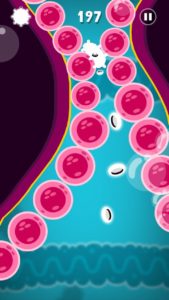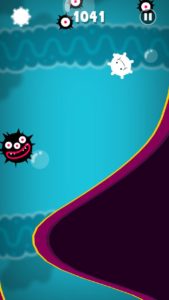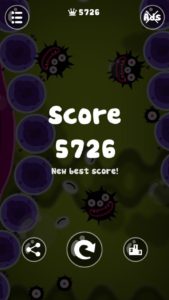For our Spatial Writing Analysis I have chosen to play “Microtrip”, which is a simple mobile arcade game. The character is a white microbe-like blob creature that travels inside what seems to be a live organism. The control of the game is the phone tilt. The microbe goes through a series of obstacles and always keeps traveling down the body tract. The goal of the game is simple and straightforward: the character needs to go as deep as possible. It is a player vs game kind of a play experience, where an individual is challenged by the game design. Its competitive aspect is individual, meaning that the game keeps a personal high score that motivates the player to continue.
The user has to tilt his/her phone to navigate the space and has a choice of collecting white cells that increase the high score and can help when the character’s life is in danger. The traveling experience is complicated by “villain” characters scattered around the path that either harm you or kill you, so the player has to dodge them in order to continue the quest. Those are live creatures that remind me of the black sea urchin; they end the player’s game when you hit them. There are also smaller needle-like obstacles that harm the player, so that the “life” displayed at the top left corner drops. However, the game is also full of beneficial bonuses shaped like pills. Those pills can help the player collect the good white cells as a magnet, make the microbe grow in size and destroy obstacles on the way, allow it to be immune to the villains for a limited amount of time, etc.

It is a procedural game with multiple levels, however, in the process of playing, it feels never-ending due to its challenging nature and minor differences between the levels. Yet I have to admit that each time I started over the layout was different, which makes the game consistently interesting and unpredictable. I personally love the visual design of the Microtrip. Its graphics are really smooth, colors are very pleasant and the sprites are well designed and coordinated into a coherent game aesthetic. The mechanics of the game are rather simple. It has a certain “gravity” feeling to it because of the tilt control, and the way the game layout and space unfold. Microtrip is a smooth down-scroll game. The created space makes the player feel like the microbe blob is falling/floating down the insides of an organism. Although the game only uses x and y axis for character movement, there is also a sense of depth. The background is contrasting with the sprites because of the clarity, contrast, saturation and color (blue on red/red on blue). It also has organ-shaped graphics that are slightly blurred, which expands our understanding of what this space is and does create a feeling of being inside a body. This means that the space accommodates the meaning or, in other words, the “plot” of the game. The fictional world of Microtrip is simply understood by the user because of its associative graphics. The space in this case is essential for understanding the game’s narrative. The shapes, colors and sprite behavior suggest that the game space is actually inside a living body. The game design is imaginary and unrealistic yet it gives just enough of a hint for the player to subconsciously understand the metaphorical interpretation of organs, tissues, cells, etc. in the game space. In Microtrip, one can observe a well-designed parallel between the fictional and the real world.

I don’t think that the perception of time is affecting the play experience much in Microtrip. The game flows smoothly. The speed changes are rare, however, the game certainly feels more rushed and chaotic when the microbe is trapped between a lot of obstacles and dangers. The desire to go as deep as possible is intriguing and addicting. This game aspect may force a passionate player to feel the need to speed up, however, I find the game’s default flow charming as it is. Also, the concept of time is present when the microbe hits one of the needle-like obstacles, and its life is slowly draining. The character will die if the player does not catch some good white cells before the life icon is completely empty. The risk of running out of time gives another twist to the play experience as it provides another rush of adrenaline (in a sense). It contributes to the player’s understanding of the game environment where danger is present and real.

Earlier in the analysis I have used the word “quest” to describe the Microtrip playing experience. However, I doubt my own choice words, since the meaning of a quest implies a certain end to the game. Yet, in Microtrip, the player does not know why the object is traveling down somebody’s organism, what is there in the end of the tract and whether there is an end at all. This endlessness paradoxically makes this game so addicting (for me personally, at least). I definitely recommend this simple arcade game as a pleasant destress activity.